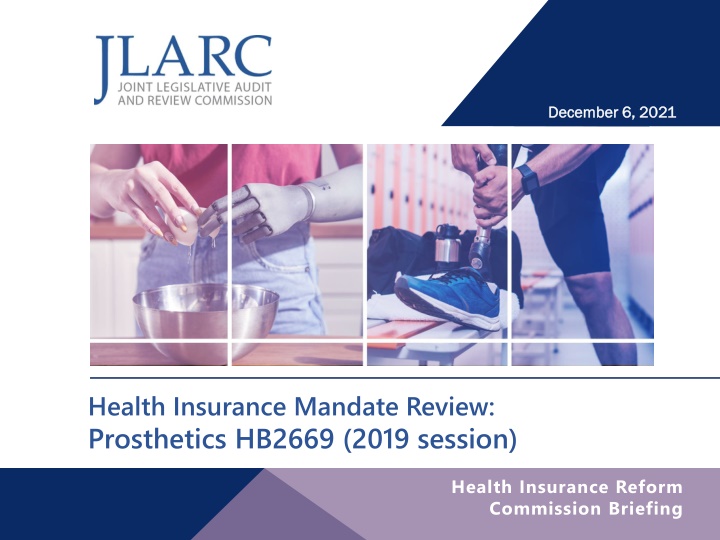
Prosthetic Limbs: Impact, Coverage, and Options
Explore the significance of prosthetic limbs in healthcare, focusing on the impact of limb loss, coverage provided by legislative mandates like HB2669, and the different types of prosthetics available. This presentation sheds light on the medical efficacy, financial implications, and prevalence of prosthetic limb use.
Download Presentation

Please find below an Image/Link to download the presentation.
The content on the website is provided AS IS for your information and personal use only. It may not be sold, licensed, or shared on other websites without obtaining consent from the author. If you encounter any issues during the download, it is possible that the publisher has removed the file from their server.
You are allowed to download the files provided on this website for personal or commercial use, subject to the condition that they are used lawfully. All files are the property of their respective owners.
The content on the website is provided AS IS for your information and personal use only. It may not be sold, licensed, or shared on other websites without obtaining consent from the author.
E N D
Presentation Transcript
December 6, 2021 December 6, 2021 Health Insurance Mandate Review: Prosthetics HB2669 (2019 session) Health Insurance Reform Commission Briefing
Questions for JLARC Stage 2 Review Is there evidence that the proposed treatment is effective? How commonly used and available is the proposed treatment? What is the cost of the treatment for individuals without insurance coverage? JLARC 2
In Brief HB 2669 would change the existing mandate to offer coverage of prosthetics to a mandated benefit. HB 2669 may also expand coverage of electric prosthetics to more amputees in Virginia. Electric prosthetics can provide greater control and balance for amputees, but a relatively small number of amputees in Virginia use electric devices. Electric prosthetics typically cost substantially more than body-powered devices. JLARC 3
In this presentation Background Medical efficacy and use of prosthetic limbs Financial impact on individuals without coverage Coverage provided by HB2669 JLARC JLARC 4
Nearly 2 million people nationwide have lost a limb Estimates suggest approximately 1.9 million people in the U.S. live with limb loss Number of people with limb loss is projected to reach 3.6 million by 2050 Estimated 43,000 people in Virginia live with limb loss Source: Ziegler-Graham, K., et al. Estimating the Prevalence of Limb Loss in the United States: 2005 to 2050. Archive of Physical Medicine and Rehabilitation, 2008. JLARC 5
Most amputations are to lower limbs and caused by vascular disease Research suggests the vast majority of amputations are to the lower extremities Approximately 70% of amputations are caused by vascular disease (e.g., diabetes, peripheral arterial disease) Most common cause of lower limb amputations Nearly 30% of amputations result from trauma Most common cause of upper limb amputations JLARC 6
Prosthetic limbs may be body-powered or electric Body-powered prosthetics controlled by the amputee, often through a system of cables and pulleys Electric prosthetics are controlled partly by electric sensors in the device Myoelectric: upper limb prosthetic controlled by sensors that receive electrical signals from amputee s muscles Microprocessor: lower limb prosthetic with sensors that control the knee based on the terrain and the amputee s foot movement and gait speed Broad range of body-powered and electric prosthetics are available for amputees JLARC 7
HB2669 requires coverage of prosthetic limbs, including electric devices Requires insurance plans to cover medically necessary prosthetic devices Includes coverage of device repair, fitting, replacement, and components Requires coverage of any myoelectric or microprocessor prosthetics covered by Medicare JLARC 8
At least 20 other states require some coverage of prosthetics JLARC 9
In this presentation Background Medical efficacy and use of prosthetic limbs Financial impact on individuals without coverage Coverage provided by HB2669 JLARC JLARC 10
Prosthetics are critical to amputees regaining functionality and independence Limb loss can result in significant functional limitations Secondary conditions resulting from limb loss include mental health concerns, sedentary lifestyle, and dependence on caretakers Many amputees with prosthetics are able to regain some functionality and return to work Many also show a reduction in secondary conditions caused by limb loss Not all amputees will need a prosthetic For example, amputees with low functional level (e.g., little ability to move before amputation) may not benefit from prosthetic legs JLARC 11
Electric prosthetics can provide greater balance and control for amputees Strong evidence shows microprocessor knees reduce falls Greater satisfaction, improved balance with microprocessor knees Smaller number of studies find improved control and satisfaction for amputees with myoelectric upper limbs More research needed to confirm efficacy of myoelectric devices Medical experts said electric prosthetics are an effective treatment for certain amputees Most helpful when amputation is above joint (knee or elbow) JLARC 12
Type of prosthetic needed depends on the amputees circumstances Need for a prosthetic is determined by physician Amputees with higher functionality generally need more complex prosthetics For example, amputee that uses fine motor skills for work may need a myoelectric arm and hand Amputees with cognitive limitations or outdoor jobs may be better suited for body-powered prosthetics Electric devices generally require more training, which may be more difficult for amputees with cognitive limitations (e.g., brain injuries) Body-powered devices are more durable and less likely to be affected by moisture and dirt outside JLARC 13
Small number of amputees in Virginia receive electric prosthetics Less than 2% of prosthetic-related charges through UVA health system or state employee insurance plan were for electric prosthetics (FY21) Medical experts also indicate only a small percentage of amputees receive electric prosthetics Small number of electric prosthetics partly reflects the most common types of amputations Above-knee amputations are less common than below- knee Relatively few upper limb amputations (which can use electric prosthetics) are above the elbow JLARC 14
Electric prosthetics are more commonly provided through the Veterans Administration Microprocessor and myoelectric prosthetics are more commonly prescribed through the VA, according to medical experts VA clinical guidelines recommend microprocessor knees reduce falls and maximize patient satisfaction JLARC 15
In this presentation Background Medical efficacy and use of prosthetic limbs Financial impact on individuals without coverage Coverage provided by HB2669 JLARC JLARC 16
Electric prosthetics cost substantially more than body-powered prosthetics Type of device Type of device Upper limb prosthetic Lower limb prosthetic Body Body- -powered cost* powered cost* $3,000 $20,000 $1,000 $4,000 Electric cost* Electric cost* $10,000 $45,000 $15,000 $50,000 For example, microprocessor legs through the state employee insurance plan cost up to $24,500 Broad range of devices accounts for cost differential Additional costs include components and fittings Cost of sockets and inserts can vary widely * Cost figures based on estimates from medical experts JLARC 17
Electric prosthetics need more frequent repair and replacement than body-powered devices Microprocessor legs may need replacement every 3 5 years Electric prosthetics more complex and prone to wear-and- tear Body-powered prosthetics are more durable and generally have longer lifespan Sockets (where prosthetics attach to limbs) need replacement for body-powered and electric prosthetics Sockets may need replacement when amputees change size and shape JLARC 18
In this presentation Background Medical efficacy and use of prosthetics Financial impact on individuals without coverage Coverage provided by HB2669 JLARC JLARC 19
Insurance plans are already required to provide some coverage of prosthetics Plans are required by the Code of Virginia to offer a policy covering prosthetics Individual and small-group plans cover prosthetics as part of the essential health benefit Plans provide varying levels of coverage for prosthetics and their repair and replacement Prosthetic devices are considered on a case-by-case basis Some electric devices are covered, but others are considered experimental Code of Virginia 38.2-3418.15 JLARC 20
HB2669 would apply to insurance plans covering approximately one-quarter of Virginians Note: 38.2-6506 A 1 prohibits qualified health plans (including those sold on the exchange) from providing state mandated benefits that are in addition to the essential health benefit (EHB). Any state mandate enacted after 2011 is considered in addition to the EHB. JLARC 21
HB2669 would expand coverage of prosthetic devices HB2669 would change the existing provision that insurance plans offer coverage of prosthetics to a mandated benefit requiring coverage HB2669 would expand the types of prosthetics required to be covered to include electric devices Microprocessor prosthetic legs Myoelectric prosthetic arms JLARC 22
JLARC staff for this report Kimberly Sarte, Associate Director Jamie Bitz, Chief Legislative Analyst Nick Galvin, Senior Associate Legislative Analyst Mitchell Parry, Associate Legislative Analyst JLARC JLARC http://jlarc.virginia.gov http://jlarc.virginia.gov/ / (804) 786 (804) 786- -1258 23 1258
Appendix: Literature reviewed Carey, S.L., et al. Differences in myoelectric and body-powered upper-limb prostheses: Systematic literature review. Journal of Rehabilitation Research and Development, 2015; 52(3): 247-262. Chen, C., et al. Economic benefits of microprocessor controlled prosthetic knees: a modeling study. Journal of NeuroEngineering and Rehabilitation, 2018; 15(Suppl 1): 62. Highsmith, M.J., et al. The effect of the c-leg knee prosthesis on sensory dependency and falls during sensory organization testing. Technology Innovation, 2014; 2013(4): 343-347. Kannenberg, A., et al. Benefits of microprocessor-controlled prosthetic knees to limited community ambulators: Systematic review. Journal of Rehabilitation Research and Development, 2014; 51(10): 1469 96. Lansade, C., et al. Mobility and satisfaction with a microprocessor-controlled knee in moderately active amputees: A multi-centric randomized crossover trial. Annals of Physical and Rehabilitation Medicine, 2018; 61: 278 285. Lansade, C., et al. Impact of C-LEG on mobility, satisfaction and quality of life in a multicenter cohort of femoral amputees. Annals of Physical and Rehabilitation Medicine, 2021; 64: 101386. Mileusnic, M., et al. Benefits of the Genium microprocessor controlled prosthetic knee on ambulation, mobility, activities of daily living and quality of life: a systematic literature review. Disability and Rehabilitation: Assistive Technology, 2021; 16(5): 453-464. Moller, S., et al. Perceived self-efficacy and specific self-reported outcomes in persons with lower-limb amputation using a non-microprocessor-controlled versus a microprocessor-controlled prosthetic knee. Disability and Rehabilitation: Assistive Technology, 2018; 13(3): 220-225. JLARC 24
Appendix: Literature reviewed, contd. Ramstrand, N., et al. Transitioning to a microprocessor-controlled prosthetic knee: Executive functioning during single and dual-task gait. Prosthetics and Orthotics International, 2020; 44(1): 27-35. Resnik, L., et al. Evaluation of EMG pattern recognition for upper limb prosthesis control: a case study in comparison with direct myoelectric control. Journal of NeuroEngineering and Rehabilitation, 2018; 15(23): 15-23. Sawers, A.B. and Hafner, B.J. Outcomes associated with the use of microprocessor-controlled prosthetic knees among individuals with unilateral transfemoral limb loss: A systematic review. Journal of Rehabilitation Research and Development, 2013; 50(3): 273-314. Sen, I.S., et al. Effects of microprocessor-controlled prosthetic knees on self-reported mobility, quality of life, and psychological states in patients with transfemoral amputations. Acta Orthopaedica et Traumatologica Turcica, 2020; 54(5): 502-506. Squella, S.A.F., et al. Enhancement of a prosthetic knee with a microprocessor-controlled gait phase switch reduces falls and improves balance confidence and gait speed in community ambulators with unilateral transfemoral amputation. Prosthetics and Orthotics International, 2018; 42(2): 228-235. Van Der Riet, D., et al. An Overview and Comparison of Upper Limb Prosthetics. 2013 Africon, 2013; 1-8. Webster, J.B., et al. Clinical Practice Guidelines for the Rehabilitation of Lower Limb Amputation: An Update from the Department of Veterans Affairs and Department of Defense. American Journal Physical Medicine and Rehabilitation, 2019; 98(9): 820 829. Ziegler-Graham, K., et al. Estimating the Prevalence of Limb Loss in the United States: 2005 to 2050. Archive of Physical Medicine and Rehabilitation, 2008; 89: 422-429. JLARC 25
Appendix: Medical experts interviewed VCU Health UVA Medical Center U.S. Department of Veterans Affairs JLARC 26






















